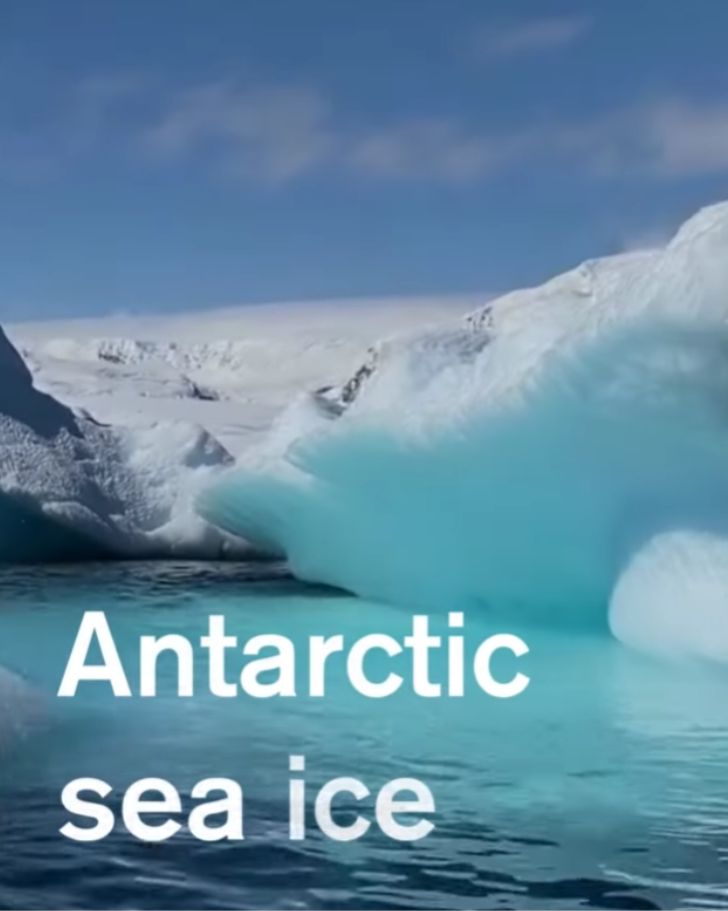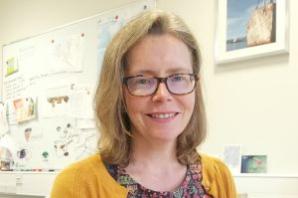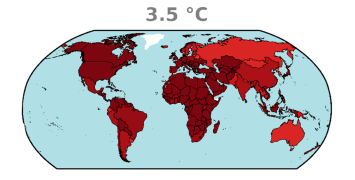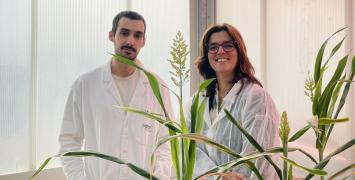Climate stories from frozen archives

By Inge Ruigrok
Erin McClymont’s project ANTSIE began almost by chance. ‘A colleague in my department studies the history of ice sheet thinning by analysing the chemistry of rocks, looking at when they were last exposed as the ice retreated. He was also using deposits left by snow petrels as evidence of when birds returned to the continent, which in turn helps date ice-sheet changes. Since I work on geochemistry - especially lipids - we thought it could be interesting to see what was inside a deposit, so we decided to open one up.’
What they found was strikingly beautiful. ‘Inside were these distinct layers, like the rings of a tree’, McClymont recalls. ‘Each layer represented a different moment in time, showing how oily residues from the birds had been preserved over centuries. We realised these layers could offer a new kind of record - a chemical history of what the birds were eating and how their environment was changing.’
A chemical time capsule
The team’s approach is rooted in geochemistry. They focus on fatty acids — lipids found in all living organisms, each with a distinctive chemical ‘fingerprint’. Fish, squid, and krill all produce different patterns, and because snow petrels make stomach oil from these fats, their deposits preserve those signatures over time. ‘By analysing them, we can tell whether the birds were eating more fish, squid, or krill at different periods’, McClymont explains.
They also measure stable isotopes of carbon and nitrogen, which reveal information on both diet and environment. Nitrogen isotopes indicate the birds’ position in the food chain, while sea-ice conditions and the availability of nutrients and carbon dioxide in the water influence carbon isotopes. Together, they demonstrate how feeding habits and environmental factors have shifted through time.
There is more hidden in the chemistry. ‘We also measure the amount of rock or dust in the stomach oil deposits,’ she adds. ‘That might sound unrelated to the birds, but it can tell us when the petrels were absent. When we find more rock and less oil, it suggests the birds weren’t nesting there as often - possibly because conditions were too harsh, with thicker sea ice, stronger winds, or heavier snow.’
By piecing together these clues, the team can trace how changes in sea ice have shaped the petrels’ feeding patterns and, in turn, what these reveals about past Antarctic climates. ‘We needed to understand what the oil actually told us - whether it reflected the birds’ diet, or wider environmental conditions. That’s why we’ve used so many different analytical techniques to piece the story together.’
Life on the ice
The team dates the samples using radiocarbon measurements, which can only go back approximately 50 000 years. ‘As a geoscientist, that doesn’t seem like very far back, 'McClymont admits, ‘but for most people, it’s an enormous span of time. Some stomach oil deposits are clearly older - perhaps 60 000 or 70 000 years, or even more - but currently there is no way to date them precisely, so they are known simply as being older than 50 000 years.’
The research is complex, not only due to the challenges posed by dating techniques but also because of the steps needed to link diet, chemistry, and environmental conditions. Furthermore, Antarctic sea ice is notoriously difficult to model with accuracy, which brings considerable uncertainty about future changes.
This complexity necessitates the inclusion of a present-day component in the project, with field teams undertaking long, isolated expeditions in Antarctica to fit GPS trackers to snow petrels and gather data on their movements and diet. ‘By understanding the birds’ current behaviour, we can better interpret what the ancient deposits are telling us,’ McClymont explains. ‘When we started, we had many questions about snow petrel ecology, and answering those has been an important part of the project.’
A window to the last Ice Age
The project’s most notable finding to date comes from a single deposit formed around 20 000 years ago during the last Ice Age, a period when the Antarctic ice sheet and surrounding sea ice were far larger than they are today. ‘The conditions were extremely harsh,’ McClymont says. ‘What astonished us was that birds were still nesting there. It is incredible that they could survive such a climate.’
Geochemical analysis revealed another remarkable detail: for about a thousand years, krill was almost entirely absent from the deposit. ‘Krill is such an iconic part of the Antarctic ecosystem - everything from whales to seabirds depends on it’, McClymont continues. ‘To find a period when it was nearly missing was striking. It showed that the ecosystem could change dramatically - probably in response to climate shifts - and yet the snow petrels adapted and survived, remaining in Antarctica despite these challenging conditions.’
Linking ecosystems and models
The snow petrel deposits do not just reveal the birds’ diet - they also provide insight into broader environmental changes. One of the project’s main challenges is that much of the data concerns the ecosystem rather than purely physical processes. ‘Climate models can give precise numbers, such as the concentration of sea ice in a specific area,’ McClymont explains. ‘Our data isn’t at that level yet. We can say whether there was sea ice, or whether it was denser or thinner, but it’s not a direct percentage, such as the models produce.’
Having sea-ice modelers on the team helps bridge the gap between quantitative model outputs and ecological data. ‘It’s challenging to translate between these two,’ she says, ‘but it’s incredibly useful, allowing us to explore how far interpretations can be pushed and to provide perspectives beyond modern observational records. Before instruments existed to measure sea ice, our understanding of its variability over time was limited. Our data reveal these long-term changes and help put recent trends into context.’
The team also compares their findings with existing simulations. ‘Although the models are still developing, they allow us to test their performance and assess how well they capture observed patterns,’ she adds. ‘Our records often span centuries or even millennia. By comparing them with sea-ice models from the last Ice Age, we can evaluate how closely those reconstructions align with what we observe in the deposits.’
Looking for human footprints
Antarctica’s sea ice does more than sustain penguins and petrels - it regulates global climate. ‘Every year, the sea ice expands and then contracts,’ McClymont explains. ‘When it expands, more sunlight is reflected into space, and the connection between the surface ocean and the deep ocean strengthens. As the ice forms, the water becomes saltier and denser, sinking into the Atlantic, Indian, and Pacific basins and driving global circulation. This process also regulates the exchange of heat and greenhouse gases between the ocean and atmosphere, carrying heat and carbon dioxide into the deep ocean and helping to reduce CO₂ in the atmosphere.’
Whether human-driven climate change is already visible in McClymont’s data remains an open question. ‘So far, our focus has been on generating and collating the long-term records. At present, we are investigating whether the variability observed in sea ice is driven by natural climate fluctuations, such as periods of warming or cooling, or if there are signs of human influence detectable in the record. This work is ongoing, and ichallenging because of the timescales involved: many of our records average decades or centuries, while recent climate change has been abrupt.’
The team focusses on the big picture: how snow petrels responded from the last glacial period to the present. ‘This transition, when the ice sheets retreated and sea ice became more like today, tells us a lot about the resilience of the birds. By understanding that, we can generate better data to compare with climate models and gain perspective on both past and potential future changes.’
From science to conservation
Beyond generating scientific knowledge, McClymont hopes the project will shift perspectives on how sea ice has evolved and highlight the cascading effects these have had on the broader ecosystem.
‘I usually work at the base of the food chain, studying lipids and other chemical tracers. This project has given me the chance to look not only at how individual organisms adapt, but also at how the entire ecosystem responds to environmental change.’
‘There is an increasing focus on management and conservation in the Southern Ocean and around Antarctica’, McClymont continues. ‘I hope our work can help inform those discussions, identifying areas where rapid or dramatic change could have serious consequences for these ecosystems.’
‘Snow petrels, for example, are not currently listed as an endangered species, but that may reflect a lack of data rather than low vulnerability. Our research confirms that they are closely tied to sea ice, relying on it for feeding and nesting. As projections show sea ice continuing to shrink, these birds could become more vulnerable. We hope this evidence will help people see snow petrels in a new light and recognise the importance of their habitat.

Biography
Erin McClymont is a Professor of Geography at Durham University researching how Earth’s climate and environments have changed over time. She studies marine, lake, and peat archives to understand interactions between oceans, ice sheets, and land across decades to millions of years. Using organic geochemistry and biomarker proxies, her work reconstructs past ocean temperatures, sea ice, hydrology, and ecosystems. A Philip Leverhulme Prize winner, she serves on the NERC Peer Review College and editorial boards for Climate of the Past and the Journal of Quaternary Science and leads international collaborations on past climate periods.






